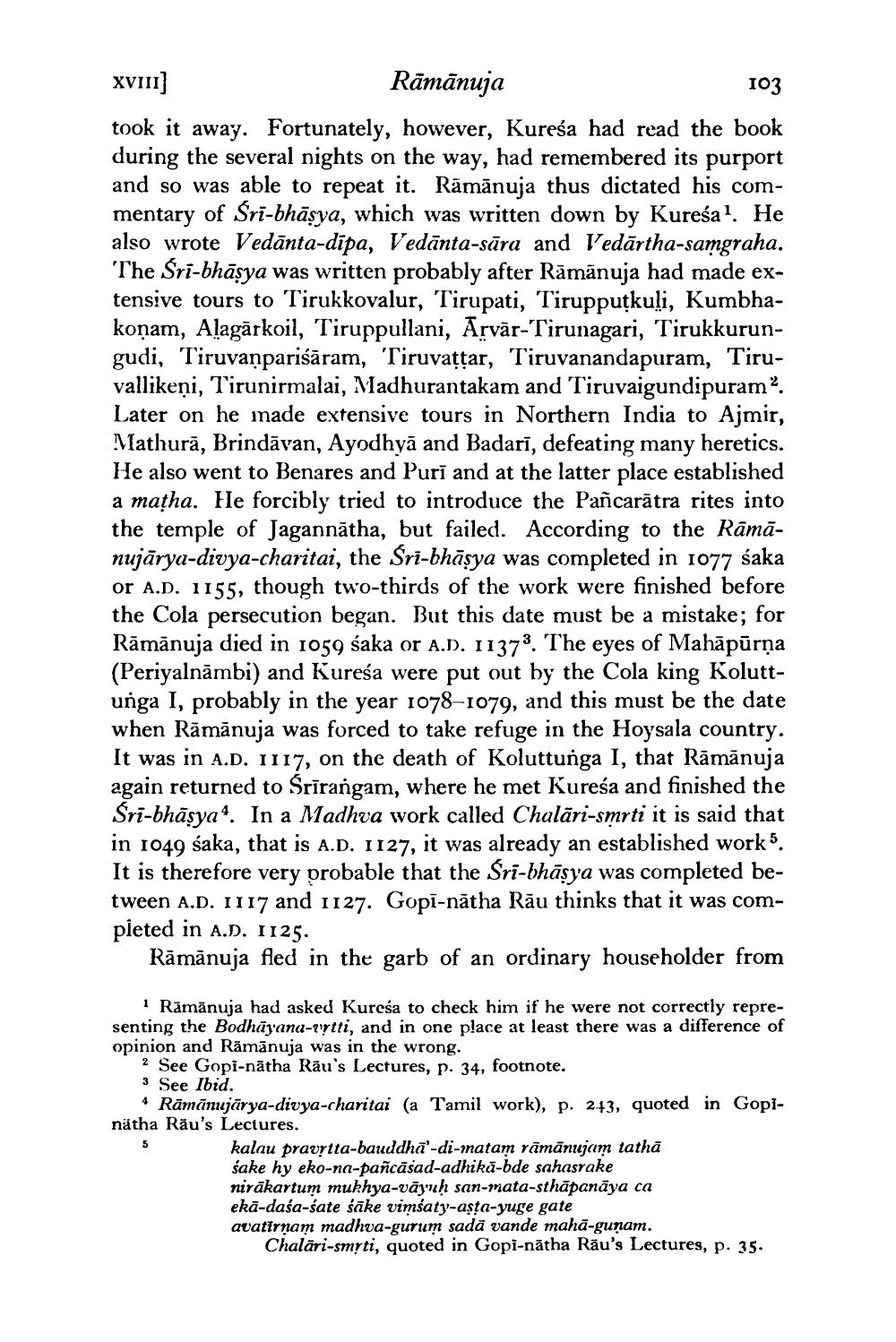________________
XVIII
Rāmānuja
103
took it away. Fortunately, however, Kuresa had read the book during the several nights on the way, had remembered its purport and so was able to repeat it. Rāmānuja thus dictated his commentary of Sri-bhāsya, which was written down by Kureśal. He also wrote Vedānta-dipa, Vedānta-sāra and Vedārtha-samgraha. The Sri-bhāsya was written probably after Rāmānuja had made extensive tours to Tirukkovalur, Tirupati, Tirupputkuli, Kumbhakoņam, Alagārkoil, Tiruppullani, Arvār-Tirunagari, Tirukkurungudi, Tiruvaņpariśāram, Tiruvattar, Tiruvanandapuram, Tiruvallikeņi, Tirunirmalai, Madhurantakam and Tiruvaigundipurama. Later on he inade extensive tours in Northern India to Ajmir, Mathurā, Brindāvan, Ayodhyā and Badarī, defeating many heretics. He also went to Benares and Purī and at the latter place established a matha. He forcibly tried to introduce the Pañcarātra rites into the temple of Jagannātha, but failed. According to the Rāmānujārya-divya-charitai, the Śrī-bhāsya was completed in 1077 saka or A.D. 1155, though two-thirds of the work were finished before the Cola persecution began. But this date must be a mistake; for Rāmānuja died in 1059 saka or A.D. 11373. The eyes of Mahāpūrņa (Periyalnāmbi) and Kureśa were put out by the Cola king Koluttunga 1, probably in the year 1078-1079, and this must be the date when Rāmānuja was forced to take refuge in the Hoysala country. It was in A.D. 1117, on the death of Koluttunga I, that Rāmānuja again returned to Srīrangam, where he met Kureśa and finished the Śrī-bhāsya4. In a Madhva work called Chalāri-smrti it is said that in 1049 saka, that is A.D. 1127, it was already an established work 5. It is therefore very probable that the Sri-bhāşya was completed between A.D. 1117 and 1127. Gopī-nātha Rāu thinks that it was completed in A.D. 1125.
Rāmānuja fled in the garb of an ordinary householder from
Rāmānuja had asked Kuresa to check him if he were not correctly representing the Bodhūyana-rytti, and in one place at least there was a difference of opinion and Rāmānuja was in the wrong.
2 See Gopi-nātha Rāu's Lectures, p. 34, footnote. 3 See Ibid.
* Rāmānujārya-divya-charitai (a Tamil work), p. 243, quoted in Gopinätha Rău's Lectures
kalau pravrtta-bauddha'-di-matam rāmānujam tathā sake hy eko-na-pañcāsad-adhikā-bde sahasrake nirākartum mukhya-vājuh san-mata-sthāpanāya ca ekā-daśa-sate sake vimsaty-aşta-yuge gate avatirņam madhva-gurum sadā vande mahā-guņam.
Chalāri-smyti, quoted in Gopi-nătha Rău's Lectures, p. 35.




